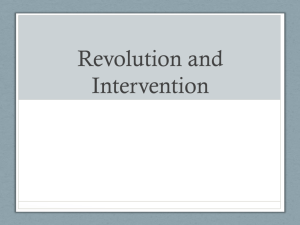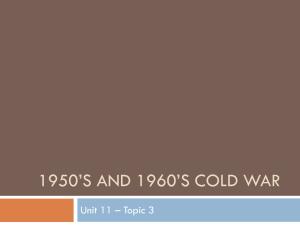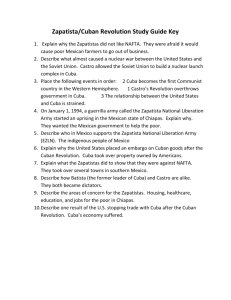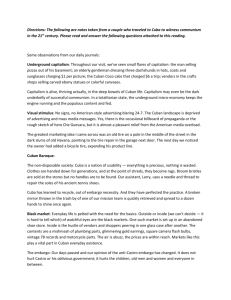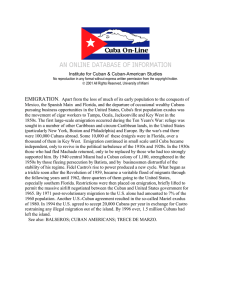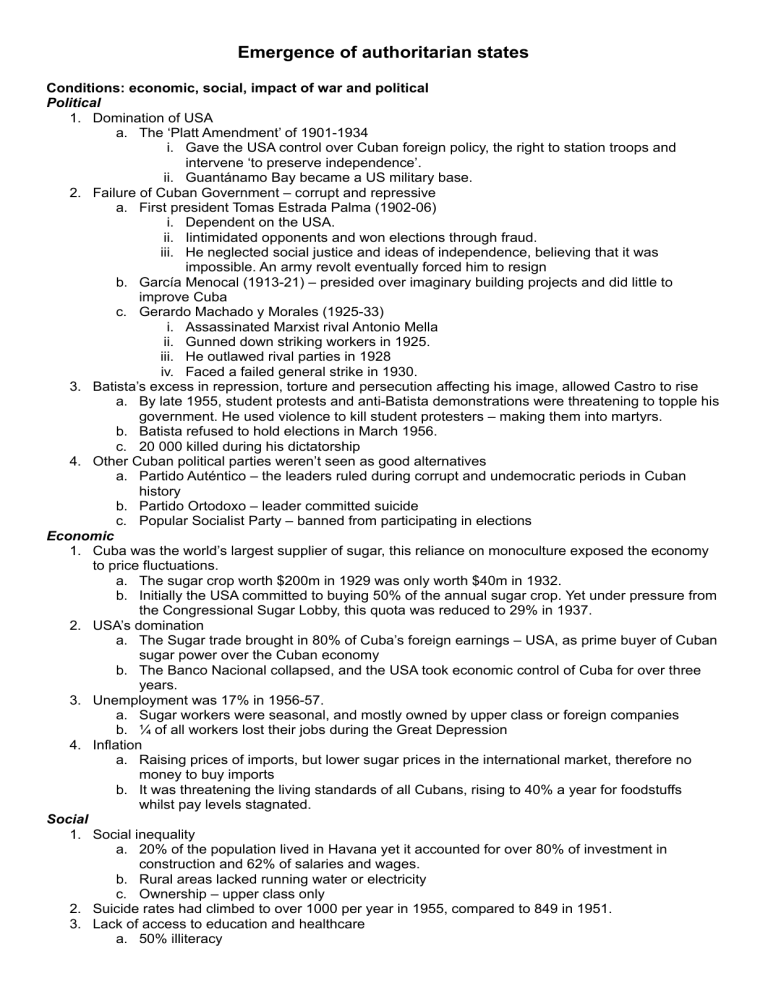
Emergence of authoritarian states Conditions: economic, social, impact of war and political Political 1. Domination of USA a. The ‘Platt Amendment’ of 1901-1934 i. Gave the USA control over Cuban foreign policy, the right to station troops and intervene ‘to preserve independence’. ii. Guantánamo Bay became a US military base. 2. Failure of Cuban Government – corrupt and repressive a. First president Tomas Estrada Palma (1902-06) i. Dependent on the USA. ii. Iintimidated opponents and won elections through fraud. iii. He neglected social justice and ideas of independence, believing that it was impossible. An army revolt eventually forced him to resign b. García Menocal (1913-21) – presided over imaginary building projects and did little to improve Cuba c. Gerardo Machado y Morales (1925-33) i. Assassinated Marxist rival Antonio Mella ii. Gunned down striking workers in 1925. iii. He outlawed rival parties in 1928 iv. Faced a failed general strike in 1930. 3. Batista’s excess in repression, torture and persecution affecting his image, allowed Castro to rise a. By late 1955, student protests and anti-Batista demonstrations were threatening to topple his government. He used violence to kill student protesters – making them into martyrs. b. Batista refused to hold elections in March 1956. c. 20 000 killed during his dictatorship 4. Other Cuban political parties weren’t seen as good alternatives a. Partido Auténtico – the leaders ruled during corrupt and undemocratic periods in Cuban history b. Partido Ortodoxo – leader committed suicide c. Popular Socialist Party – banned from participating in elections Economic 1. Cuba was the world’s largest supplier of sugar, this reliance on monoculture exposed the economy to price fluctuations. a. The sugar crop worth $200m in 1929 was only worth $40m in 1932. b. Initially the USA committed to buying 50% of the annual sugar crop. Yet under pressure from the Congressional Sugar Lobby, this quota was reduced to 29% in 1937. 2. USA’s domination a. The Sugar trade brought in 80% of Cuba’s foreign earnings – USA, as prime buyer of Cuban sugar power over the Cuban economy b. The Banco Nacional collapsed, and the USA took economic control of Cuba for over three years. 3. Unemployment was 17% in 1956-57. a. Sugar workers were seasonal, and mostly owned by upper class or foreign companies b. ¼ of all workers lost their jobs during the Great Depression 4. Inflation a. Raising prices of imports, but lower sugar prices in the international market, therefore no money to buy imports b. It was threatening the living standards of all Cubans, rising to 40% a year for foodstuffs whilst pay levels stagnated. Social 1. Social inequality a. 20% of the population lived in Havana yet it accounted for over 80% of investment in construction and 62% of salaries and wages. b. Rural areas lacked running water or electricity c. Ownership – upper class only 2. Suicide rates had climbed to over 1000 per year in 1955, compared to 849 in 1951. 3. Lack of access to education and healthcare a. 50% illiteracy b. Rural areas suffered from poor health and educational services with a ratio of 1:227 doctors in Havana compared to 1:2423 in Oriente. Consolidation and maintenance of power Use of legal methods, force, charismatic leadership, and propaganda Legal methods 1. Provisional government was established in January 1959 formed by liberals a. However real authority was in Castro, who was the commander of Cuban armed forces and formed the ORPC in Jan 1959 – unofficial committee composed of his closest advisors 2. Banned all political parties through Urrutia’s provisional government a. Castro’s refused to hold elections in April 1959 3. Castro stepped as a Prime Minister a. Allowed him to implement reforms that led to the country’s transformation into communist by the end of 1961 4. Integrated Revolutionary Organization (ORI) – 1961, revolutionary organizations that acted against Batista were unified into ORI and became a political party a. In 1965 it became a Cuban Communist Party under Castro’s leadership, and became the only officially authorized political party, as other parties cannot participate in elections i. It began to publish it’s own newspaper (Granma), develop youth branch (Young Communist League), children’s organizations (José Martí Pioneers) 5. Agrarian Reform Act a. Aim – aimed at equal redistribution of land, making the agriculture more efficient, and Cuba less dependent on sugar. It also restricted the land that could be owned; anyone owning above the established limit had their extra part expropriated and received bonds as compensation. 6. Increase in wages and reduction of rents a. Reaction – created great enthusiasm amongst the lower class but antagonized the middle/upper class. b. Foreign companies – faced worker’s strikes that took advantage of favorable political situation to demand increase in wages/working conditions. They were threatened with expropriation, accused of representing countries that provided Batista with weapons. c. Government – supported the strikes and intervened in them, in favor of the workers. 7. Import taxes on luxury goods a. Effects in Cuba – the good were more expensive, reducing their imports so Cubans spent less money on them. With the money raised from the taxes the government hoped to invest into industrialization and diversify the economy. 8. Education and health reforms – improving living conditions a. The reforms allowed Castro and PSP to become popular, there was a level of resistance to the changes, as groups opposed to the pace of the revolution took up arms in some parts of the country, local opposition was controlled by the government and did not lead to major crisis, because Castro allowed those against the revolution to leave the country Force 1. Committees for the Defence of Revolution – established in September 1960 for civil defense, in every city district a. Members were instructed to identify ‘enemies of the revolution’ and report on their activities. By the end of its first year, the CDR had more than 800,000 members and had become an important tool in government surveillance. Charismatic leadership 1. Daily speeches appealed to people’s hope for new ideas, based on the grand ideas of the leader of the independence, ideas of social justice, economic security and political freedom a. In his speech in Santiago de Cuba, 3rd of January, 1959, after the overthrow of Batista, he promised: i. Work for the unemployed, land for rural workers, improved working conditions for the urban workers. The middle class were promised they would be able to become professionals; women that they would be able to work in equal conditions to men 2. General style was milder and warmer than other’s one-party state 3. Good relationship with the public – ordinary people could approach him and speak of their dissatisfactions a. Went out on the streets and travelled across the country to meet face to face b. Spent afternoon in rural villages discussing who should repair tractors or fix refrigerators for the people Propaganda 1. Newspaper and radio stations were censored and forced to close if they angered the government 2. Broadcasted on Radio Rebelde – used media to explain his aims and policies 3. Image of an engaged leader through his speaker skills a. Great charisma – noticeable when he b. Many had faith in him, as long as he was in charge c. Castro was seen as legitimate – based on his identification with the heroic myths of Cuban patriotism and on his personal ethics (did not use his position to build up a fortune) 4. His nationalistic speech, together with his appeal to the idea that Cuba’s integrity was threatened by imperialism and that it was essential for Cubans to remain united and follow the directives of the government Nature, extent and treatment of opposition 1. Removed people associated with Batista’s regime a. Citizens who served to Batista’s government and armed forces were imprisoned or executed and properties confiscated, as brought to trail i. 1961 – Persecution of Batista’s followers b. Waves of Cuban emigrants went to exile to USA, many were Batista’s supporters, then disillusioned middle class liberals, members of the business and professional élites who opposed Castro i. Mariel Boatlift in 1980 125 000 Cubans left 2. Hubert Matos – leader of the 26th of July Movement - decided to resign as a Military Chief of Camagüey because of the increasing influence of communist ideas in the revolution a. This would be a great embarrassment for Castro, therefore Castro ordered Cienfuegos to put Matos under arrest for conspiracy and treason against the revolution b. Shortly after that, Cienfuegos’s plane disappeared in an accident 3. Church a. Whenever bishops criticized the policies of the revolution, Castro accused them of abandoning their pastoral duties and getting involved in politics b. The nationalization of schools and government’s decision that religious education could only take place in churches, increased tension c. In an attempt to show there was no room for putting religious beliefs before the revolution, the constitution of 1976 stated that ‘It is illegal and punishable by law to oppose one’s faith or religious belief to the Revolution, education or the fulfilment of the duty to work, defend the homeland with arms, show reverence for its symbols and other duties established by the constitution.’ 4. Military Units to Aid Production a. Between 1965 and 1968, about 25,000 young men were sent to UMAP labour camps b. Anyone opposing military service on whatever grounds was sent to these camps, together with a variety of other ‘offenders’: children of political prisoners, youngsters imitating American dress codes and tastes, homosexuals, and political dissenters. 5. Escambray Rebellion a. Soldiers loyal to Batista continued to fight from the Escambray Mountains, joined later by those who did not like the pro-communist leanings and dissatisfied peasants b. Given US military aid, but after the Bay of Pigs Invasion USA cut off funding c. Castro’s counterintelligence were uncovering and arresting CIA agents and quickly defeated the rebels The impact of the success and/or failure of foreign policy on the maintenance of power 1. The Bay of Pigs Invasion (1961) a. Washington was planning to invade Cuba using Cuban exiles, trained as a paramilitary force in order to overthrow Castro b. It was a failure: as troops landed in the Bay of Pigs, Castro’s forces defeated them and imprisoned 1000+ participants c. Castro emerged more powerful i. It has shown that Castro has made Cuba a more powerful country giving credibility to the revolution, because they were able to defeat USA ii. Reinforced Cuban nationalism and his hero-worship – he led the resistance against the invasion iii. The visible enemy gave Castro a reason to demand increasing commitment and that Cubans needed to remain united in the face of another attack 2. Cuban Missile Crisis (1962) a. Washington and Moscow confronted each other over the Soviet placement of nuclear missiles in Cuba b. After negotiants the Soviets removed it and dismantled the area, whilst US removed its own nuclear missiles from Turkey and made a promise not invade Cuba c. That meant Soviets will no longer defend the island 3. Supporting national liberation movements worldwide a. Believed to protect Cuba he needed to assist leftist revolutions in other nations b. As Soviet Union did not want to escalate the Cold War, they restricted economic assistance c. However sometimes Cuban intervention served Soviet purposes such as in the Angolan Civil War (1975-1991) i. Supplied troops to help the left-wing Movement for the Liberation of Angola to gain control of the country and remain in power ii. Castro claimed the intervention was a moral duty of Cuba and was fighting against apartheid, and emphasized African origin of a large part of the Cuban population, describing the war as an opportunity to repay the injustices of slavery iii. News of progress reached Cuba and contributed to Castro’s popularity and rise in national pride among Cuban citizens Aims and results of policies Aims and impact of domestic economic, political, cultural and social policies Economic policies 1. Communist direction; Che Guevara a. Policy i. Che Guevara favored a centrally planned economy – emphasis on moral incentives and self-sacrifice (work for ideas and values of the revolution, not personal gain) ii. Rents has been reduced by 50% in 1959, were not abolished iii. In 1962 Cuba Changed national currency, any savings in banks were lost overnight iv. Agrarian Law 1963 reduced the amount of land that could be owned – preventing wealthy peasantry 1. After 1963 state owned 70% of land b. Consequences i. Caused obstacles in Cuba in economics plans of increasing productivity ii. Lack of specialized labour that left the country iii. Moral incentives were not efficient – low productivity and quality 1. Farmers were forced to sell to the state at low prices – no incentives iv. Low sugar production prevents the government from diversifying 2. Industrialization program a. Bought machinery from Soviet Union b. Increased its debt i. To reduce its debt it returned to intensive sugar production as they were trapped in trade relations of subsidized sugar in exchange for goods 3. Revolutionary Offensive a. Policy i. Emphasized the idea that a man whose work was a social duty rather than a way to achieve personal gain ii. Expropriation of privately owned enterprises and were to be managed by the state. b. Consequences i. Did not achieve productivity ii. Increased administrative chaos as the number of government agencies needed to organize the different fields of production and sales grew exponentially. 4. The Year of Ten Million 1970 a. Policy i. Aimed at breaking sugar production record and reaching a 10-million-ton output in 1970 to pay off Cuban debts to Soviets and by selling surplus sugar make investments to achieve economic diversification 1. Became a battle for the Cuban pride, and show those skeptical of the revolution that it is possible and establish Castro’s political power ii. ‘militarization of labor’ everyone worked together as ‘volunteers’ 1. Armed forces occupied sugar mills 2. To motivate people theatres and bars, Christmas and New Years were cancelled b. Consequences i. Harvest reached 8.5 million tons ii. Agricultural machines had been over-used iii. Agriculture production of other crops had suffered; forestry and fishing seen losses iv. Exhausted Cubans and made them skeptical v. Oversee soldiers felt as their status was diminished as they had to watch people cut cane vi. Political blow for Castro – had to accept dependency on Soviet Union, and abandon Guevara’s ideas vii. Farmer’s markets were reinstated, state owned companies were given autonomy, material incentives were introduced (overtime pay), Cuba suffered the same economic problems 5. The Reactivation Campaign 1986 a. Policy i. Advocated a return to the values of voluntarism. The aim was to ‘rectify errors and negative tendencies’ linked to the relaxation of communist principles after 1970. ii. Farmers’ markets were again banned iii. Bonuses and extra pay were abolished iv. Self-employment was discouraged v. Farm cooperatives were given new emphasis as, under a new Agrarian Reform Act, the percentage of land managed by independent farmers dropped to 2 per cent vi. Labour discipline was enforced and the workers lost many union rights. b. Consequences i. Decreased productivity ii. Reduced milk, oil, textiles, sugar supplies and increased prices iii. Black markets appeared to offer goods difficult to obtain iv. Transport and electricity rates were affected, decreasing living standard 6. The Special Period 1991 a. Dissolution of Soviet Union led to economic disaster as Cuba was highly dependent on them i. Soviets provided subsidized goods, oil, loan, technicians that overlooked Cuban projects b. Entered the period in order to respond to the unrest i. A large percentage of state-owned farms began to be run as worker-managed cooperatives to increase levels of productivity ii. Cuba opened to international business to attract capital and diversify economic activities 1. Foreigners were invited to join the state in the development of certain areas of the economy: tourism, mining, and energy. iii. Farmers’ and handicraft markets reappeared, some level of self-employment and private businesses was allowed iv. The state aimed at saving money by reducing some subsidies and increasing taxes Political policies 1. 1976 Constitution a. Under it Fidel Castro became head of state, head of the government, president of the Executive Committee of the Council of Ministers, first secretary of the Central Committee of the PPC, and commander-in-chief of the armed forces b. Although the National Assembly was created, and elected provincial and municipal authorities were established, the 1976 constitution brought little change in practice. The National Assembly only met twice a year for a period of four to five days c. In 1992, the constitution was revised i. The first direct elections for deputies to the National Assembly were held, where Cubans were allowed to choose from a list of party candidates approved by the government ii. Freedom of religion became a constitutional right d. Nevertheless, Castro held emergency powers enabling him to suspend the constitution, freedom of association to protest against government policies were not granted, and all mass media has been controlled by the state since 1960s Social polices 1. Education a. The literacy campaigns – 1961 was ‘The Year of Education’ i. Policy 1. Military barracks were turned into educational complexes, and new schools were built in rural areas to solve the shortage of buildings 2. Implementation of a training program for 271 000 teachers, and they were sent across the country to teach people in their homes, these brigadistas in the lived with rural families during the campaign ii. Consequences: 1. By 1962, illiteracy dropped to 4% 2. Increased the hopes in the revolution 3. Volunteers emerged from the experience transformed as many of them were middle-class literate youth who familiarized themselves with the hardships of the poor; acted in service and self-sacrifice 4. Peasantry started supporting the revolution as they learned what it could do for them b. Impact on schools, teachers, and students i. Private school were nationalized, boarding schools opened, large scholarships for gifted students established ii. New teachers came to replace those who did not support the revolution, and then realized the students were acted as spies iii. New textbooks were adopted, and teaching focused on the revolution and the lives of the heroes iv. Libraries were purged of what was considered to be inappropriate material 2. Health a. Policy: i. The government enlisted 750 physicians and medical students to work in the mountains and coastal communities where there was little or no access to medical services. ii. Rural Medical Service – had as its aim to 'provide disease prevention and to revitalize health services for those most in need, whether because they are poor, in precarious health or live far from urban centres”. iii. Another key feature of the Cuban health system has been the multi-specialty polyclinics which were established in the 1970s. b. Consequences i. the infant mortality rate dropped from 60 per thousand of live births in 1958 to 13.3 in the mid 80s ii. Life expectancy rose from 57 to 74. 3. Religion a. Castro nationalized schools thus removing all religious influence. Castro meanwhile viewed Catholicism as representing foreign interests and would not allow bishops to get involved in political or social commentary b. The 1976 constitution made it clear that: It is illegal and punishable by law to oppose one’s faith or religious belief to the Revolution, to education or to the fulfillment of the duty to work, defend the country with arms, show reverence for its symbols and fulfill other duties established by the Constitution c. This situation changed and in 1998 the Pope, John Paul II visited Cuba; the constitution was amended, and people allowed to join the Catholic church. Cultural policies 1. First Congress of Cuban Writers and Artists a. Cuba organized in response to concerns of artists who feared that Castro would dictate the themes and contents of their work b. ‘Words to the intellectuals’ – speech at the congress Castro gave i. He defined the responsibilities of artists in times of revolution when Cuba was being threatened by the enemy. ii. The intellectuals were no longer free to create what they wanted; they were at the service of the revolution and had to work to strengthen its values. iii. Inspiration for art had to come from what the revolution demanded of the artist c. Poets wrote to encourage people to work in the zafra or the coffee harvest; novels described women who were role models at work and at home; films highlighted the achievements of the revolution, such as Manuel Herrera’s Girón, which represented the Bay of Pigs incident, or Jorge Fraga’s Me hice maestro (I Became a Teacher). 2. The Padilla affair, 1971 a. Hubert Padilla a poet had become disappointed with the revolution and was arrested and tortured. He delivered a forced confession in a staged public trial. b. Padilla’s detention and trial had an enormous impact in Cuba and among intellectuals worldwide. Numerous artists intervened on Padilla’s behalf and asked Castro to respect freedom of expression. Many of them broke away from the revolution. 3. Grey period a. Followed by the affair b. Artists were afraid to produce anything potentially considered counter revolutionary c. Closer surveillance of their actions and work was carried out by the state and extended to other forms of academic and scientific activities. d. The 1976 constitution established that ‘there is freedom of artistic creation as long as its content is not contrary to the revolution’ 4. Newspapers, magazines and radio stations that spoke out against Castro or the communist influence were often threatened with closure unless they changed their political stance The impact of policies on women and minorities Women 1. Equal rights to access all types of jobs– to achieve modernization and produce record harvests women needed to become an active part of the workforce a. Offered training at technical and professional levels to prepare them for posts with greater responsibility b. Entered fields that have been dominated by males e.g. IT c. Agrarian Reforms acts gave opportunity for women to work in areas limited to men, driving tractors d. Opened up day care centers so women could become part of the workforce 2. Family Code 1970s – men were to share in the household duties and the education of children, not doing so was seen as exploitation of women 3. Article 44 of the Cuban Constitution (1976) stating that, “The state guarantees women the same opportunities and possibilities as men in order to achieve women’s full participation in the development of the country”, it seemed that by 1980 there had not been substantial progress towards a genuine change in women's status in society: 4. The Cuban Women’s Federation a. Policy i. Aimed at helping women integrate into the revolution ii. Trained women in new jobs; farming, construction, teaching iii. Organized campaigns against illiteracy and health programs iv. Worked with Ministry of Education in the design of new textbooks, where women were portrayed as committed workers v. Former domestic workers were trained to work as cooks or seamstresses, and received education in history, geography and the new laws of revolutionary Cuba b. Consequences i. Women were still expected to be the housewives, and men refused to share household responsibilities or live with economically independent women, resulting in women giving up work ii. Women involvement in the workforce was still lower than the government hoped for as they faced discrimination in work environment iii. Low number of women in decision-making positions iv. Only 13.2% of the membership of the Communist Party were women v. The government seemed to be more interested in increasing workforce rather than equality 5. Vilma Espin a. Created the Cuban Women’s Federation and promoted equal rights b. FMC was involved in mobilizing females to join the workforce, training them, educating them and promoting to join the revolutionary forces c. Involved in supply and organizing the 26th of July Movement as an underground spy d. Served as a member of the Central Committee, First Lady of Cuba (sister-in-law, then wife), member of the Council of State e. Represented Cuba in UN’s General Assemblies Minorities 1. Policies a. Castro passed policies to desegregate beaches, parks, work sites and social clubs. He outlawed all forms of legal and overt discrimination, including discrimination in employment and education. b. Economic and social reforms had a positive impact on the majority of Afro-Cubans i. Access to housing, education and health services improved as did the representation of Afro-Cubans in a range of professions. 2. Consequences a. Declared that the Revolution had eliminated racism, making any further discussion of racial inequalities a taboo subject. b. Many argue that racism continued to exist and that, for example, educational policy and official culture remained strongly Euro-centric. c. Afro-Cubans had limited representation in the higher levels of the Communist Party – or civil service or state industries. d. During the Special Period, racial tensions resurfaced. i. Remittances in dollars sent by Cubans overseas to their families in Cuba improved the status of white Cubans more than that of black Cubans. This is because about 85 per cent of Cubans overseas were white.
